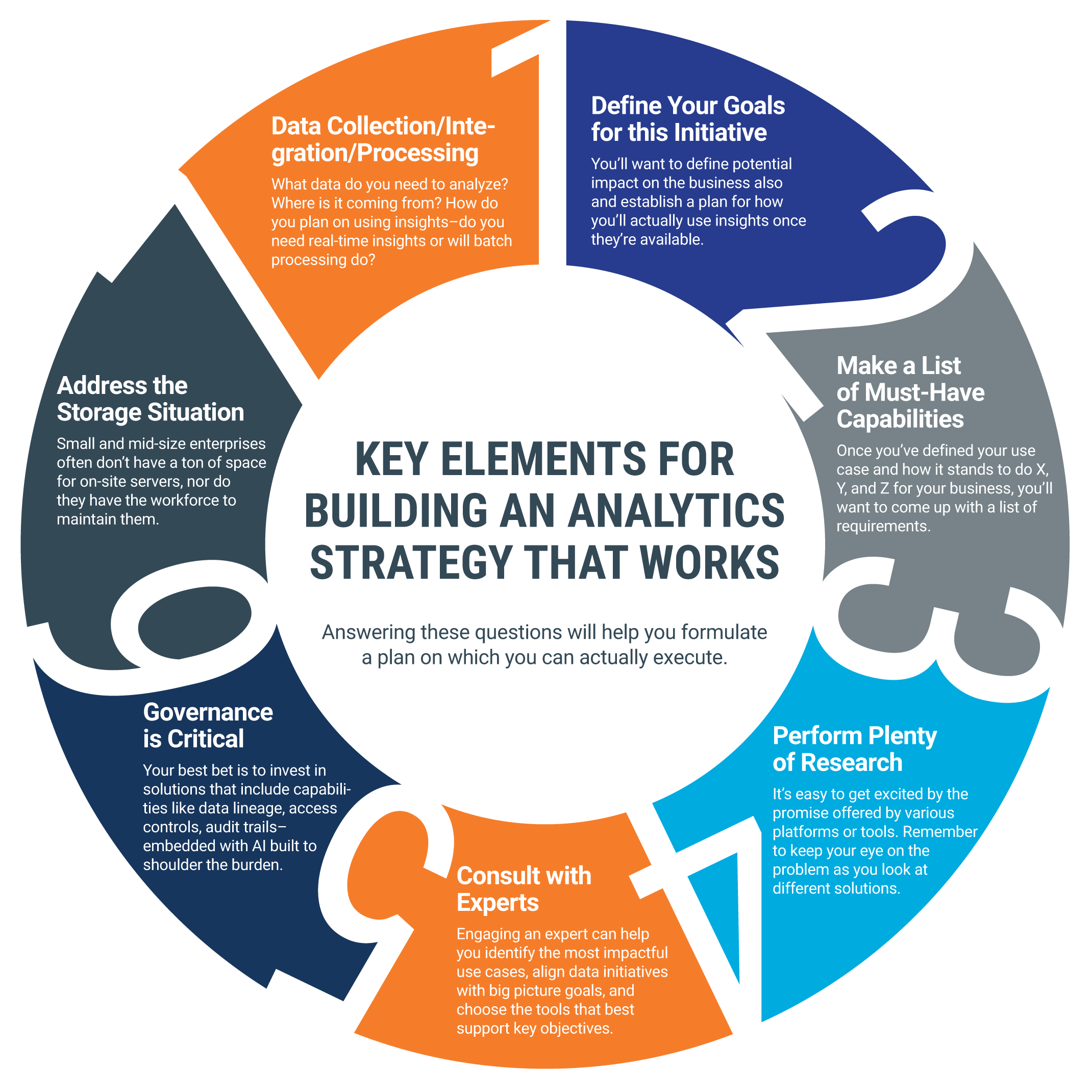
A Data Analytics Strategy for Mid-Sized Enterprises
In a recent report, IDC researchers found that mid-size enterprises that make digital transformation a priority are twice as likely to see double-digit revenue gains and four times less likely to report losses than peers who don’t embrace innovation. For many mid-sized enterprises, data analytics, along with innovations in AI, machine learning, and predictive analytics, are allowing them to compete in a whole new league.
While large corporations still have the advantage when it comes to resources and in-house talent, size isn’t the competitive advantage it once was. Today, mid-sized organizations can access the same insights, intelligence, and computing power as their big-name counterparts—often with more flexibility to act on opportunities as they emerge.
Companies that can solidify their Big Data and analytics strategy now could soon emerge as the next generation of market leaders.
Benefits and Challenges of Data Analytics Closely Related
As it stands, rising IoT adoption is the biggest growth driver for Big Data analytic solutions. For manufacturing companies, sensors and devices can turn legacy equipment into a smart machine, serving up valuable production insights that can be analyzed along with ERP systems, financial reports, and customer satisfaction metrics.
Retail brick-and-mortars leverage RFID tags to manage inventory, and IoT sensors tracking foot traffic optimize customer journeys across digital and physical realms. Meanwhile, farmers use sensors to monitor equipment and environmental conditions while connected drones monitor crops from above.
These use-cases and countless others represent massive opportunities for mid-sized companies in all sectors. But AI-enabled analytics tools and IT infrastructure are required to unlock those opportunities. And according to a 2019 Digitalist article, mid-size organizations struggle to extract value from Big Data strategies for two key reasons: internal culture, particularly where change management is concerned, and scalability limitations that cause delays.
With 5G and WiFi 6, the IoT is about to become faster and more reliable. Organizations failing to prepare are likely to face even more Big Data challenges down the road.
How Can Mid-Sized Businesses Use Big Data Analytics?
Mid-size businesses can leverage Big Data analytics to generate a wide range of benefits. Here are are three key use-cases:
- Learn what makes customers tick. Data and intelligence innovations are completely changing the game for marketing, sales, and customer service teams. According to an IDC report, real-time data from sources like smartphones, GPS, wearables, and other Internet-enabled devices—combined with transactional and behavioral data, business intelligence systems, and other sources—make it easy for brands to improve customer experience and product innovations. While marketing analytics tools and automation platforms have been around for a while, smarter solutions like experience management platforms kick things up a notch by bringing operational data and customer insights into a central hub.
- Identify trends, opportunities, and new markets. Where traditional BI tools were once reserved for analysts, consulting groups, and data scientists, today’s solutions are self-serve, affordable, and a far cry from the clunky, expensive reports of the past. Business users with zero data science expertise can use real-time data visualization tools to analyze the internal and external factors that could boost business performance or cause things to slow down. Brands can identify and respond to trends as they emerge and find untapped markets with potential customers with a high propensity to buy. Analytics platforms with AI and ML capabilities can add even more value in the form of guided decision-making, predictive modeling, and automation.
- Use predictive analytics. Today’s predictive analytics solutions draw on more than historical insights and use data from a wide range of sources to model the impact of different scenarios and predict possible outcomes. Brands are using AI-enabled analytics platforms for a wide range of use cases, including fraud detection, optimizing marketing campaigns, product development, and more.
Mid-Sized Enterprise Data Analytics: Key Strategy Elements
Mid-sized enterprises don’t have as much room for trial and error as say, Netflix or Amazon, which means implementing a Big Data analytics strategy can be both a high-risk and a high-reward initiative. Here are some best practices to help you develop a focused Big Data strategy that’s right for your organization:

- Define Your Goals. Before getting started, determine what you hope to accomplish with your Big Data analytics strategy. Are you looking for a 360-degree view of the customer? Hoping to capitalize on trends like deep learning, machine learning, and dark data before your competitors? Do you want to streamline operations or use predictive maintenance to save time and money? Whatever it is, you also want to define its potential impact on the business and establish a plan for how you will use the insights once they’re available.
- Make a List of Must-Have Capabilities. Once you define your use-case and how it stands to do X, Y, and Z for your business, come up with a list of requirements.You may want to consider analytics-as-a-service platforms, which allow you to pay for access to insights while vendors handle the specifics of the architecture.
- Perform Plenty of Research. Find out what similar companies are doing with Big Data. What tools are they using? What kind of results are they seeing? Once you identify some tools, sign up for free trials or demos to get a sense of whether a solution is right for your company. It’s easy to get excited by the promise offered by various customer experience platforms or the fact that IoT devices and sensors allow you to turn almost anything into a data source. Remember to keep your focus on the problem as you look at different solutions.
- Consult with Experts. While any organization can benefit from working with an expert, mid-size businesses often don’t have the internal talent to take on Big Data projects. Working with an expert can help you identify the most impactful use cases, align data initiatives with big picture goals, and choose the tools that best support key objectives. If you have an in-house IT department, the right consultant can help you figure out how to best leverage their skills and fill gaps with a mix of AI solutions and outsourced experts.
- Governance Is Critical. Companies now need to comply with CCPA and GDPR requirements or face hefty fines that could undermine their reputation or put them out of business. New state laws are moving through the pipeline and may add more compliance rules into the fold. When non-compliance charges can cost thousands of dollars per record, one tiny oversight can swiftly take out your growing empire.
Here, your best bet is to invest in Big Data analytic solutions that include capabilities like data lineage, access controls, and audit trails—all embedded with AI built to help shoulder the burden. - Address the Storage Situation. Small and mid-size enterprises often don’t have a ton of space for on-site servers, nor do they have the workforce to maintain them.
For companies with minimal IT/cybersecurity experience, we recommend working with an expert who can help you evaluate storage solutions and their associated costs, capacity, and security considerations. - Data Collection/Integration/Processing. What data do you need to analyze? Where is it coming from? How do you plan on using insights? Do you need real-time insights or will batch processing do? This is another area where working with an expert is likely your best bet.
Data Analytics Now Essential for Survival
While some may still believe that Big Data analytics falls under the purview of Big Tech and corporate America, there’s no shortage of evidence proving that’s no longer the case. Tools have become more accessible and affordable and could be the driving force in leveling the playing field. Additional factors like rising customer expectations and COVID-related supply chain issues are converging, making Big Data analytics not only a “nice-to-have,” but an essential for future survival.
[adinserter name=”Data Analytics CTA”]
Recent blog posts

Stay in Touch
Keep your competitive edge – subscribe to our newsletter for updates on emerging software engineering, data and AI, and cloud technology trends.



